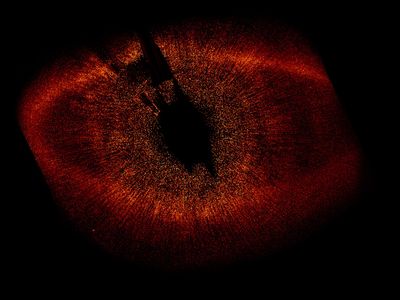NASA shows first photos of far-off planets

WASHINGTON – Earth seems to have its first fuzzy photos of alien planets outside our solar system, images captured by two teams of astronomers.
The pictures show four likely planets that appear as specks of white, nearly indecipherable except to the most eagle-eyed experts. All are trillions of miles away – three of them orbiting the same star, and the fourth circling a different star.
None of the four giant gaseous planets is remotely habitable or remotely like Earth. But they raise the possibility of others more hospitable.
It’s only a matter of time before “we get a dot that’s blue and Earthlike,” said astronomer Bruce Macintosh of the Lawrence Livermore National Lab. He led one of the two teams of photographers.
Macintosh’s team used two ground-based telescopes, while the second team relied on photos from the 18-year-old Hubble Space Telescope to gather images of the exoplanets – planets that don’t circle our sun. The research from both teams was published in Thursday’s online edition of the journal Science.
In the past 13 years, scientists have discovered more than 300 planets outside our solar system, but they have done so indirectly, by measuring changes in gravity, speed or light around stars.
NASA’s space sciences chief Ed Weiler said the actual photos are important. He compared it to a hunt for elusive elephants: “For years we’ve been hearing the elephants, finding the tracks, seeing the trees knocked down by them, but we’ve never been able to snap a picture. Now we have a picture.”
In a news conference Thursday, Weiler said this fulfills the last of the major goals that NASA had for the Hubble telescope before it launched in 1990: “This is an 18 1/2 -year dream come true.”
There are disputes about whether these are the first exoplanet photos. Others have made earlier claims, but those pictures haven’t been confirmed as planets or universally accepted yet. Alan Boss, an exoplanet expert at the Carnegie Institution of Washington, and Harvard exoplanet hunter Lisa Kaltenegger both said more study is needed to confirm these photos are proven planets and not just brown dwarf stars.
MIT planetary scientist Sara Seager, at the NASA press conference, said earlier planetary claims “are in a gray area.” But these discoveries, “everybody would agree is a planet,” said Seager, who was not part of either planet-finding team.
The Hubble team this spring compared a 2006 photo to one of the same body taken by Hubble in 2004. The scientists used that to show that the object orbited a star and was part of a massive red dust ring which is usually associated with planets – making it less likely to be a dwarf star.
Macintosh’s team used ground-based telescopes to spot three other planets orbiting a different star. That makes it less likely they are a pack of brown dwarf stars.
The planet discovered by Hubble is one of the smallest exoplanets found yet. It’s somewhere between the size of Neptune and three times bigger than Jupiter.
It circles the star Fomalhaut, which is Arabic for “mouth of the fish.” It’s in the constellation Piscis Austrinus and is relatively close by – a mere 148 trillion miles away, practically a next-door neighbor by galactic standards. The planet’s temperature is around 260 degrees, but that’s cool by comparison to other exoplanets.
The planet is only about 200 million years old, a baby compared to the more than 4 billion-year-old planets in our solar system.